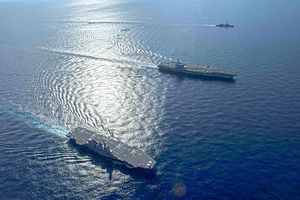JS Izumo, a Japanese Maritime Self-Defense Force (MSDF) helicopter destroyer, joined the U.S. Navy’s USS Ronald Reagan supercarrier in the South China Sea for a three-day exercise.
According to MSDF officials who spoke to NHK, Izumo and USS Ronald Reagan tested information sharing systems. The U.S. Navy and MSDF carried out their first-ever joint exercise in the South China Sea in October 2015. That exercise came the same week the United States carried out its first freedom of navigation operation near a Chinese artificial island in the Spratly group.
The Izumo‘s activities in the South China Sea also involved it playing an escort role for “U.S. military vessels,” according to NHK. This would mark the first time any Japanese MSDF vessel has played such a role in the South China Sea since the activation of Japan’s new security legislation.
According to the U.S. Navy, U.S. vessels that participated in drills with the Izumo and USS Ronald Reagan included the Ticonderoga-class guided-missile cruiser USS Shiloh, the Arleigh Burke-class and guided-missile destroyers USS Barry and USS McCampbell. MSDF Takanami-class destroyer JS Sazanami also participated in the drills.
The Izumo earlier escorted a U.S. Navy supply ship in the Pacific in May 2017, marking the first time that the MSDF was ordered to protect the assets of an allied state. These MSDF activities were enabled by the entry-into-force of Japan’s Permanent International Peace Support Law and the Legislation for Peace and Security in March 2016.
The law, which was based off the revised U.S.-Japan defense cooperation guidelines which were updated in 2015, allows the MSDF to escort and protect U.S. forces in peacetime.
Japan has supported U.S. freedom of navigation patrols in the South China Sea, which have seen strong opposition from China. Though the MSDF has yet to participate in these patrols, Japanese officials have said that Tokyo would continue to engage in bilateral naval drills with the United States in the South China Sea.
Speaking in Washington, D.C., in September 2016, Japanese Minister of Defense Tomomi Inada said that the MSDF would participate in “joint training cruises with the U.S. Navy, bilateral and multi-lateral exercises with regional navies, [and provide] capacity building assistance to coastal nations.”
The Izumo, the lead ship of the Izumo-class of helicopter destroyers, is the largest warship Japan has operated since the end of the Second World War; it is on a multi-month deployment to the South China Sea and the Indian Ocean, where it will participate in the trilateral U.S.-India-Japan Malabar 2017 exercises.
Though the MSDF classifies the Izumo-class of warships as “helicopter destroyers,” at 27,000 tons under full load, the vessels are capable helicopter carriers, designed for an anti-submarine warfare mission. Though the Izumo lacks arresting and catapulting equipment to function as a conventional aircraft carrier, analysts expect it to be able to operate certain short take-off and vertical take-off fighter aircraft, including perhaps the F-35B.
JS Kaga, the second vessel of the Izumo-class, was commissioned into the MSDF in March 2017.

































